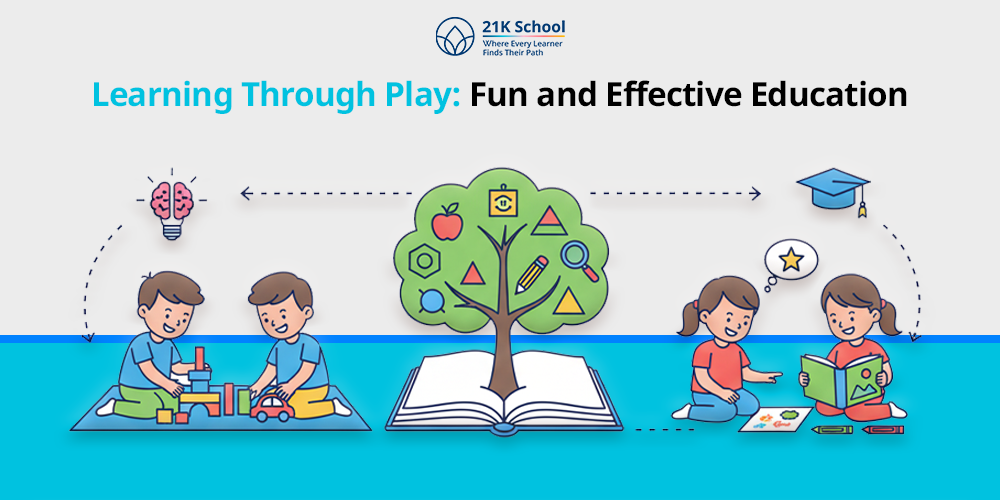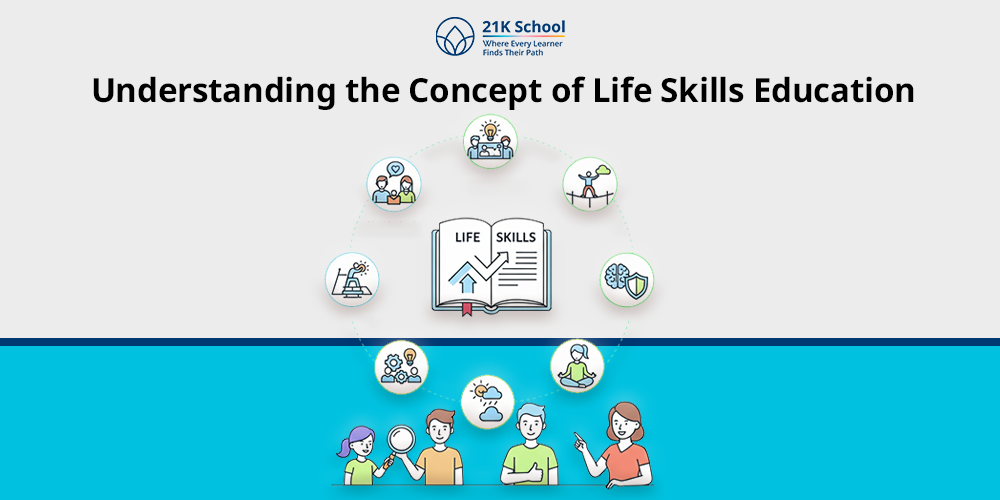
Early classroom learning is filled with engaging and creative activities for students where they learn different skills. But what if teachers include “Learning Through Play”.
Today a lot of schools include learning through play in their curriculum to increase children’s curiosity and excitement.
In this modern education system in India various exciting techniques like learning through play ensures cognitive development, problem-solving skills, encourages communication etc.
For effective implementation of learning through play teachers and schools should understand what learning through play is its importance and useful examples.
Table of Contents
- What is Learning Through Play?
- 5 Key Benefits of Learning Through Play
- Examples of Learning Through Play Activities
- 1. For Preschoolers:
- 2. Building with Blocks:
- 3. Role play (doctor, shopkeeper, teacher)
- 4. Sorting Games
- 5. For Primary Students:
- 6. Science Experiments
- 7. Educational Board Games
- 8. Storytelling or puppet shows
- 9. For Older Students:
- 10. Simulation Games
- 11. Collaborative group projects
- 12. Strategy-Based Games or Digital Learning Apps
- Conclusion
What is Learning Through Play?
Learning through play is a popular educational method which includes activities that engage students to learn and play together.
It is an ideal approach to improve 21st century skills for students like problem-solving, communication, creativity, and collaborative skills.
Learning through play is carefully designed fun learning activities that bring joy in children’s faces. Through this way kids can experiment, question, and discover new things.
5 Key Benefits of Learning Through Play
Go through a detailed exploration on key benefits of learning through play to understand the it’s real use:
1. Boosts Cognitive Development
Learning through play enhances students’ cognitive development in which they improve their thinking skills, make connections, and look for innovative ideas.
For example, a kid uses a different formula to solve maths problems. It is also ideal for attention span, memory retention, and conceptual understanding.
It is a foundation for students success and lifelong learning.
2. Enhances Problem-Solving and Creativity
Students who learn through play often find innovative solutions that showcase creative thinking skills and ability to solve complex problems.
For example, role-play games are one of the ideal ways to understand the roles of responsibility of different characters like teacher, doctor, principal etc.
Problem-solving also promotes resilience in which students work hard after setbacks.
3. Strengthens Communication and Language Skills
Communication and language skills are two important parts that can be learned in the classroom by playing different kinds of activities.
They learn how to communicate, negotiate, and express thoughts and ideas in different topics.
Choosing various languages for discussion and debate stimulates the brain to think differently.
4. Improves Physical Coordination and Motor Skills
Learning through play is not limited to educational understanding but also improves physical coordination and fine and gross motor skills.
Activities involve coordination, balance, or movement improve kids concentration and focus which leads to better academic performance and good marks.
5. Promotes Social Skills and Teamwork
Play involves connection and collaboration with other students, teachers or family members.
This helps students develop teamwork and social skills like empathy, turn-taking, discussion, and conflict resolution.
For example, working together in a science experiment to understand the outcome and write conclusions.
Examples of Learning Through Play Activities
Let’s understand some simple examples of learning through play activities for preschoolers, primary students and others.
1. For Preschoolers:
Play based learning is ideal for preschoolers which includes different activities like:
2. Building with Blocks:
How it helps: Kids playing with blocks is beneficial to enhance spatial awareness, balance, and problem-solving skills.
Activity idea: Let them make different structures and ask questions related to the structure.
Learning outcome: They understand balancing concepts, how to strengthen while building and different shapes.
3. Role play (doctor, shopkeeper, teacher)
How it helps: Role-play is an ideal opportunity for kids to understand empathy and responsibilities of character.
Activity idea: Kids can become toy shop owners or stationary shop owners and use materials and remember names.
Learning outcome: This will help to understand real life scenarios and improve vocabulary and object names.
4. Sorting Games
How it helps: Through sorting games students develop fine motor control and logical thinking.
Activity idea: Teachers can ask kids to sort objects based on colour, size, shape etc.
Learning outcome: It is a popular game to help them to understand the common pattern and counting.
5. For Primary Students:
In this stage children are excited to explore new things which help them to enjoy and gain knowledge:
6. Science Experiments
How it helps: science experiments in this stage help kids to increase their curiosity and build foundation for in-depth learning.
Activity idea: Starting with a simple baking soda experiment for growing plants at home can be effective.
Learning outcome: They observe and learn how experiments work in real life.
7. Educational Board Games
How it helps: Educational Board games are ideal for student interaction and critical thinking skills.
Activity idea: Scrabble, Monopoly, or Math Bingo can be played.
Learning outcome: Kids learn patience and sportsmanship.
8. Storytelling or puppet shows
How it helps: Storytelling or puppet shows improve communication skills and ability to engage people.
Activity idea: Storytelling through drawing, short story in classroom, or puppet shows are popular ideas.
Learning outcome: It improves student engagement, imaginative power and creative thinking skills.
9. For Older Students:
Playing can be designed as experiential learning which connects concepts into real life situations:
10. Simulation Games
How it helps: It helps in decision-making, planning, and adapting.
Activity idea: Business simulations, model UN, and SimCity etc.
Learning outcome: Students develop problem-solving critical thinking and analytical skills.
11. Collaborative group projects
How it helps: Collaborative group projects are effective ways to make connections, guide each other and take help in difficult situations.
Activity idea: Classroom project, science experiment, designing a school magazine etc.
Learning outcome: Students learn how to develop critical thinking, effective sharing, social and interpersonal skills.
12. Strategy-Based Games or Digital Learning Apps
How it helps: Combining technology with fun learning activities helps students to
Activity idea: Kahoot!, Minecraft Education, or quiz-based learning are effective activities for students.
Learning outcome: Students develop digital literacy, strategy development, and quick reasoning.
Conclusion
Learning without distraction or stress can be possible if parents and facilitators implement effective teaching methods.
One of the popular techniques is learning through play where students understand simple to difficult concepts while playing different activities.
Activities such as building a block tower, performing a puppet show, designing a digital game etc which are ideal to improve their skills.
Some common benefits of including play-based learning activities boost children’s cognitive, social, and emotional development.
Explore powerful educational techniques to build a better and positive learning environment for kids.

